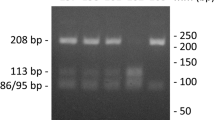Abstract
Introduction and hypothesis
Pelvic organ prolapse has a multifactorial etiology. There is increasing evidence that genetic factors greatly impact its development. This study aimed to evaluate the possible relation of the collagenous polymorphism −1997 G/T with genital prolapse in Brazilian women.
Methods
A cohort study of 180 women with stage 0 or I (group A) pelvic organ prolapse disorder and 112 women with stage III or IV (group B) was conducted. Blood DNA was isolated, and the −1997 G/T polymorphism was identified by amplifying a region of the COLIA1 gene starting prior to the protein’s coding sequence.
Results
No significant difference in the prevalence of genotypes TG and TT was found between groups (p = 0.67); differences were not found even when patients were grouped by the presence of 0 or ≥ 1 polymorphic alleles (p = 0.46). Age and home birth were found to be independent risk factors for prolapse.
Conclusions
Our study could not find any association between the −1997G/T polymorphism and genital prolapse in Brazilian women.

Similar content being viewed by others
References
Digesu GA, Chaliha C, Salvatore S, Hutchings A, Khullar V. The relationship of vaginal prolapse severity to symptoms and quality of life. BJOG. 2005;112(7):971–6.
Olsen AL, Smith VJ, Bergstrom JO, Colling JC, Clark AL. Epidemiology of surgically managed pelvic organ prolapse and urinary incontinence. Obstet Gynecol. 1997;89:501–6.
Rodrigues AM, Girão MJ, da Silva ID, Sartori MG, Martins KF, Castro RA. COL1A1 Sp1-binding site polymorphism as a risk factor for genital prolapse. Int Urogynecol J Pelvic Floor Dysfunct. 2008;19:1471–5.
Sioutis D, Economou E, Lambrinoudaki I, Tsamadias V, Creatsa M, Liapis A. Sp1 collagen I A1 polymorphism in women with stress urinary incontinence. Int Urogynecol J. 2011;22:835–9.
Miedel A, Tegerstedt G, Mæhle-Schmidt M, Nyrén O, Hammarström M. Nonobstetric risk factors for symptomatic pelvic organ prolapse. Obstet Gynecol. 2009;113(15):1089–97.
Tegerstedt G, Miedel A, Mæhle-Schmidt M, Nyrén O, Hammarström M. Nonobstetric. Obstetric risk factors for symptomatic prolapse: a population-based approach. Am J Obstet Gynecol. 2009;194:75–81.
Martins Kde F, de Jármy-DiBella ZI, da Fonseca AM, et al. Evaluation of demographic, clinical characteristics, and genetic polymorphism as risk factors for pelvic organ prolapse in Brazilian women. Neurourol Urodyn. 2011;30(7):1325–8.
Lammers K, Lince SL, Spath MA, et al. Pelvic organ prolapse and collagen-associated disorders. Int Urogynecol J. 2012;23:313–9.
Altman D, Forsman M, Falconer C, Lichtenstein L. Genetic influence on stress urinary incontinence and pelvic organ prolapse. Eur Urol. 2008;54(4):918–22.
Lince SL, van Kempen LCLT, Vierhout ME, Kluivers KB. A systematic review of clinical studies on hereditary factors in pelvic organ prolapse. Int Urogynecol J. 2012;23:1327–36.
Singh M, Singh P, Singh S, Juneja PK, Kaur T. A haplotype derived from the common variants at the 21997G/T and Sp1 binding site of the COL1A1 gene influences risk of postmenopausal osteoporosis in India. Rheumatol Int. 2013;33:501–6.
Jin H, Evangelou E, Ioannidis JPA, Ralston SH. Polymorphisms in the 5′ flank of COL1A1 gene and osteoporosis: meta analysis of published studies. Osteoporos Int. 2011;22:911–21.
Jackson SR, Avery NC, Tarlton JF, Eckford SD, Abrams P, Bailey AJ. Changes in metabolism of collagen in genitourinary prolapse. Lancet. 1996;347:1658–61.
Takano CC, Girão MJBC, Sartori MGF, et al. Analysis of collagen in parametrium and vaginal apex of women with and without uterine prolapse. Int Urogynecol J. 2002;13:342–5.
Haylen BT, de Ridder D, Freeman RM, et al. An international urogynecological association (IUGA)/international continence society (ICS) joint report on the terminology for female pelvic floor dysfunction. Neurourol Urodyn. 2010;29(1):4–20.
Bortolini MAT, Rizk DEE. Genetics of pelvic organ prolapse: crossing the bridge between bench and bedside in urogynecologic research. Int Urogynecol J. 2011;22:1211–9.
Ward RM, Edwards DRV, Edwards T, Giri A, Jerome RN, WU JM. Genetic epidemiology of pelvic organ prolapse: a systematic review. Am J Obstet Gynecol. 2014;211(4):326–35.
Feiner B, Fares F, Azam N, Auslender R, David M, Abramov Y. Does COLIA1 SP1-binding site polymorphism predispose women to pelvic organ prolapse? Int Urogynecol J Pelvic Floor Dysfunct. 2009;20(9):1061–5.
Cho HJ, Jung HJ, Kim SK, Choi JR, Cho NH, Bai SW. Polymorphism of a COLIA1 gene Sp1 binding site in Korean women with pelvic organ prolapse. Yonsei Med J. 2009;50(4):564–8.
Skorupski P, Miotła P, Jankiewicz K, Rechberger T. Polymorphism of the gene encoding alpha-1 chain of collagen type I and a risk of pelvic organ prolapse—a preliminary study. Ginekol Pol. 2007;78(11):852–5.
Cartwright R, Kirby AC, Tikkinen KA, et al. Systematic review and metaanalysis of genetic association studies of urinary symptoms and prolapse in women. Am J Obstet Gynecol. 2015;212(199):e1–24.
Leng B, Zhou Q, Zuo M. Association of COL1A1 Sp1-binding site polymorphism with susceptibility to pelvic organ prolapse: a meta-analysis. Int J Clin Exp Med. 2016;9(2):580–7.
Lee SW, Cho HH, Kim MR, et al. Association between pelvic organ prolapse and bone mineral density in postmenopausal women. J Obstet Gynaecol. 2015;35:476–80. Early Online: 1–5.
Acknowledgments
The authors thank the FAPESP (Fundação de Amparo à Pesquisa do Estado de São Paulo) for financially supporting this research under contract 2014/01107-6.
Author information
Authors and Affiliations
Ethics declarations
Conflicts of interest
None.
Additional information
Synopsis
In this cohort study, original in the literature, we could not identify any association between collagenous −1997G/T polymorphism and pelvic organ prolapse in Brazilian women.
Rights and permissions
About this article
Cite this article
Palos, C.C., Timm, B.F., de Souza Paulo, D. et al. Evaluation of COLIA1-1997 G/T polymorphism as a related factor to genital prolapse. Int Urogynecol J 31, 133–137 (2020). https://doi.org/10.1007/s00192-018-3833-x
Received:
Accepted:
Published:
Issue Date:
DOI: https://doi.org/10.1007/s00192-018-3833-x



